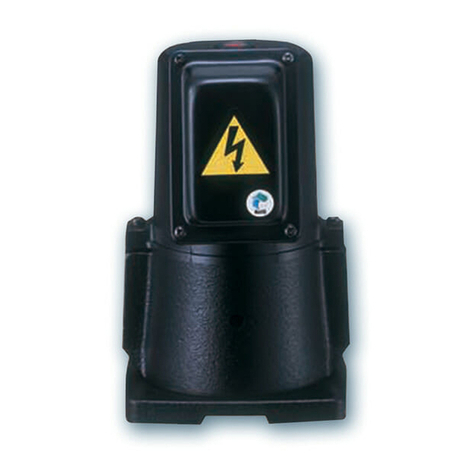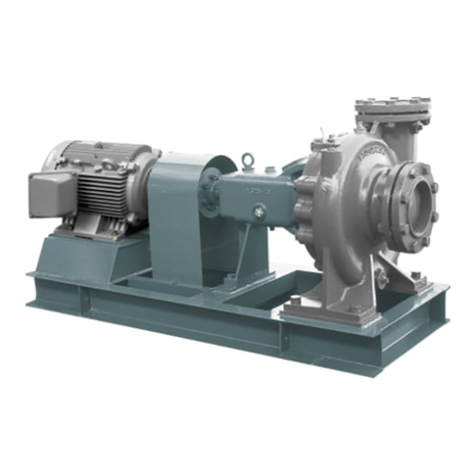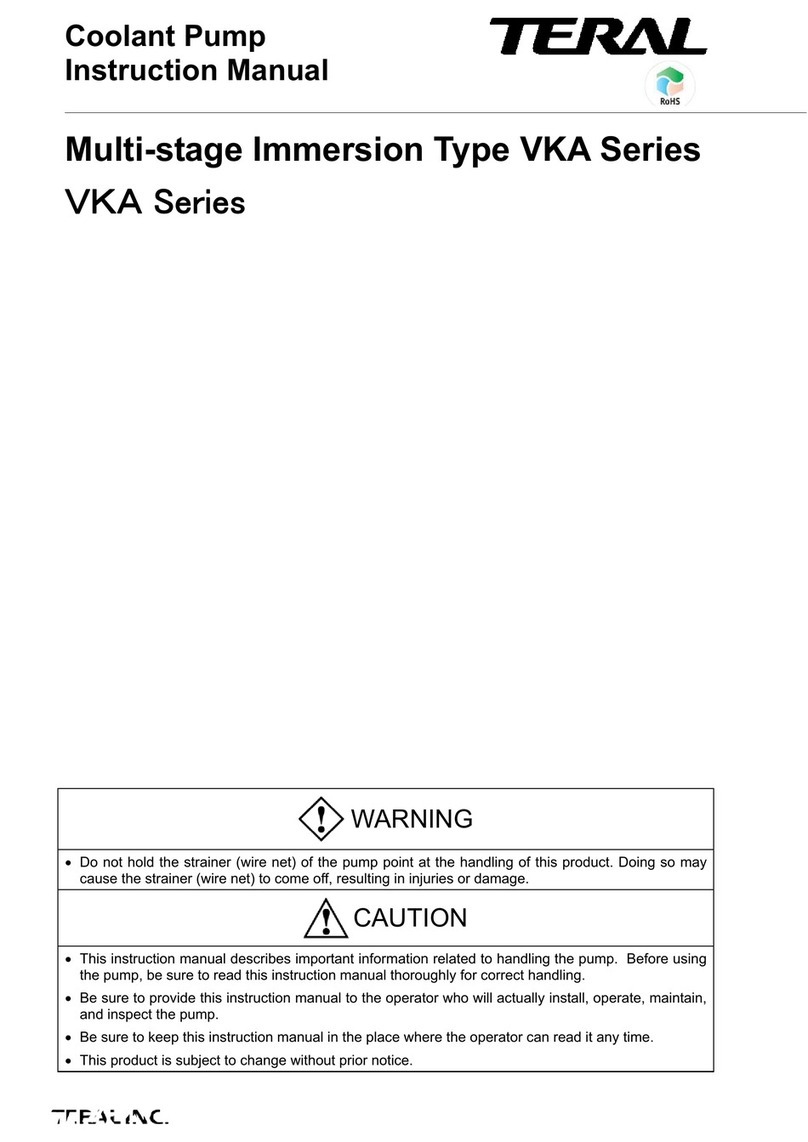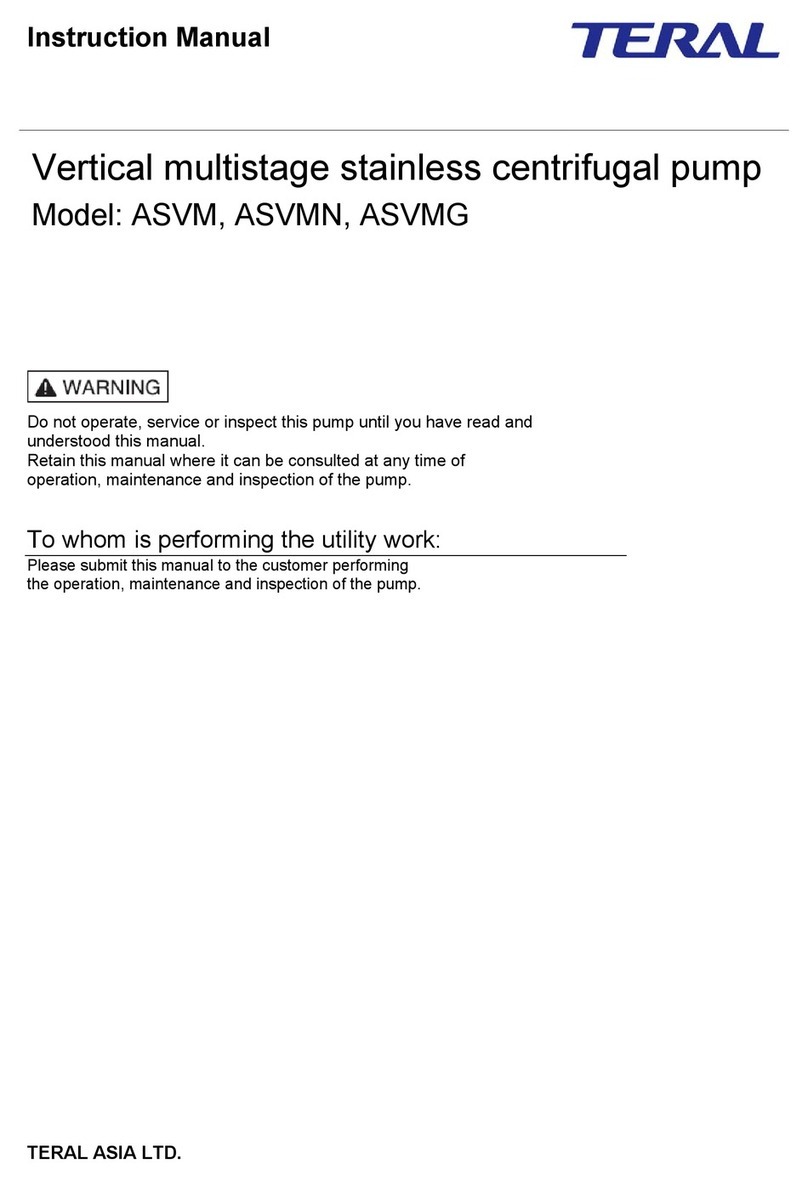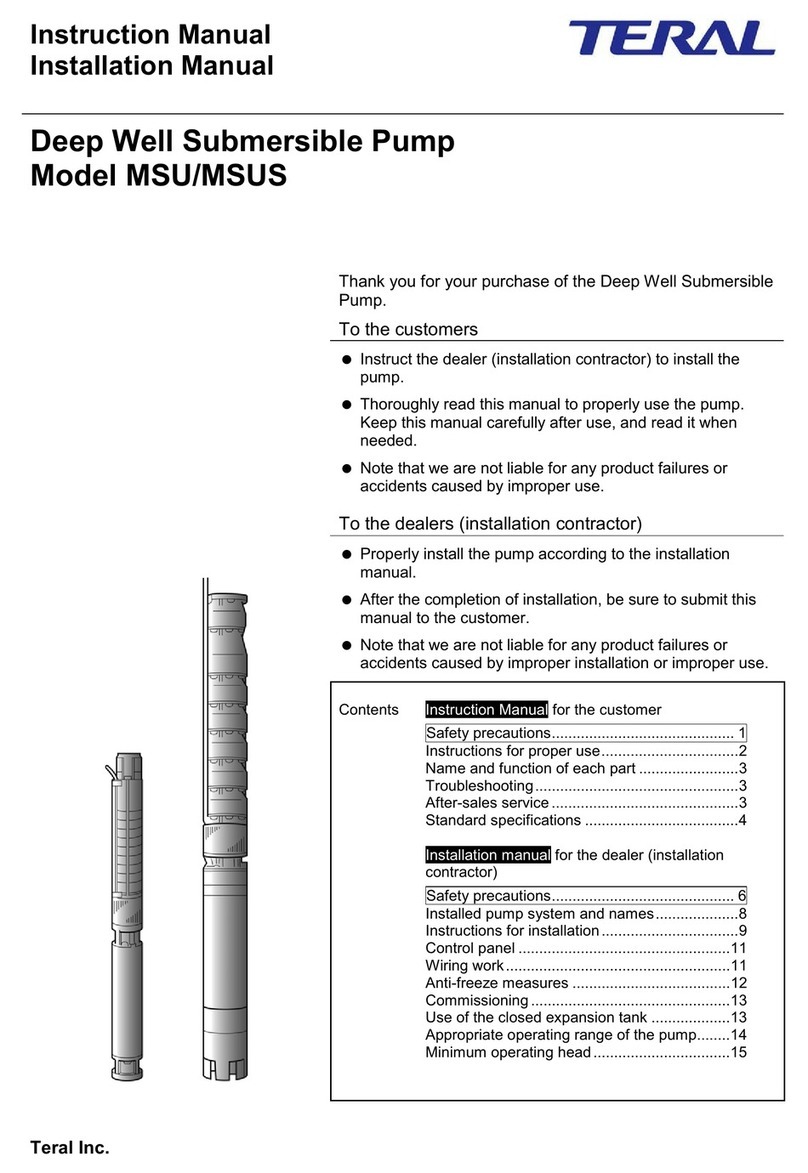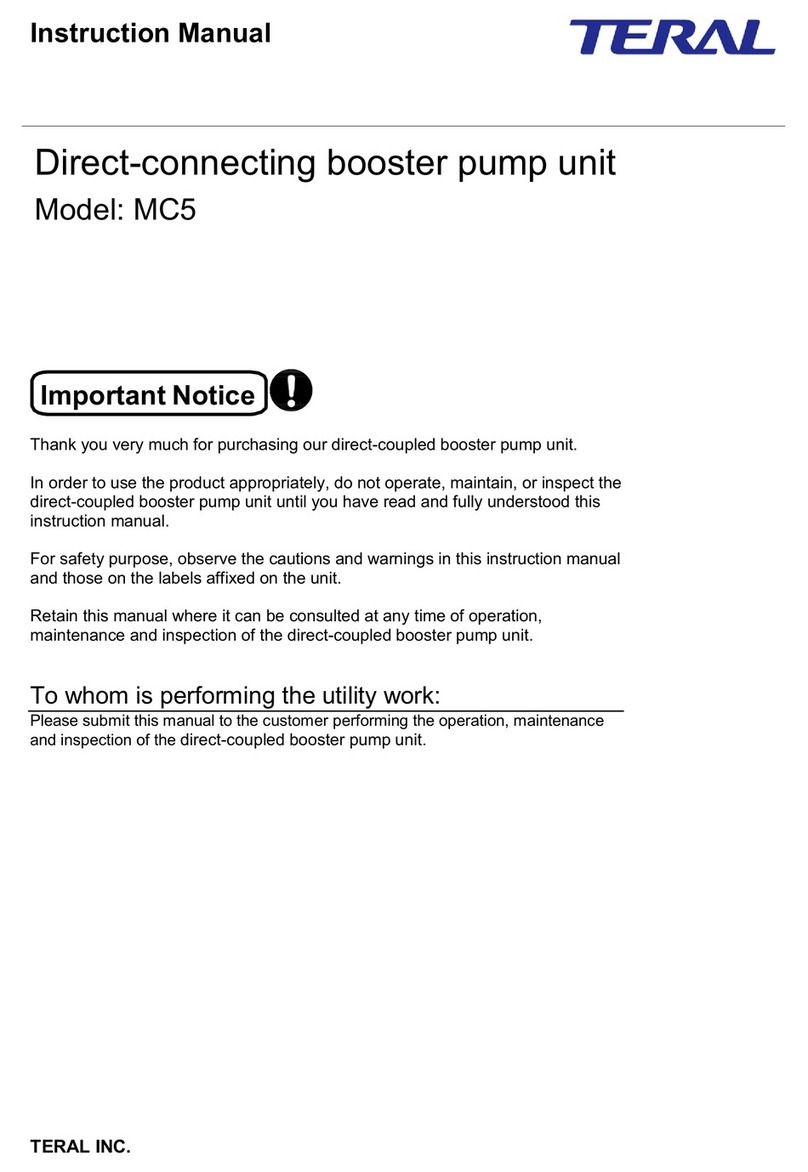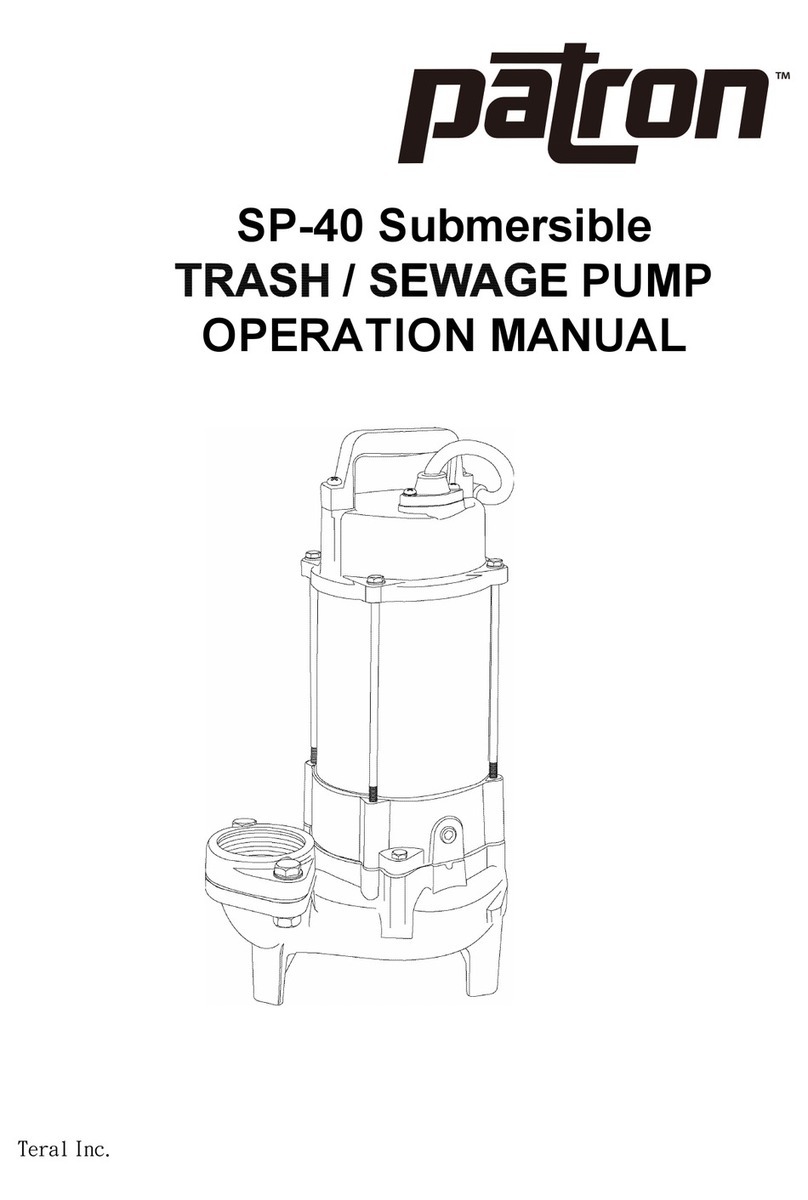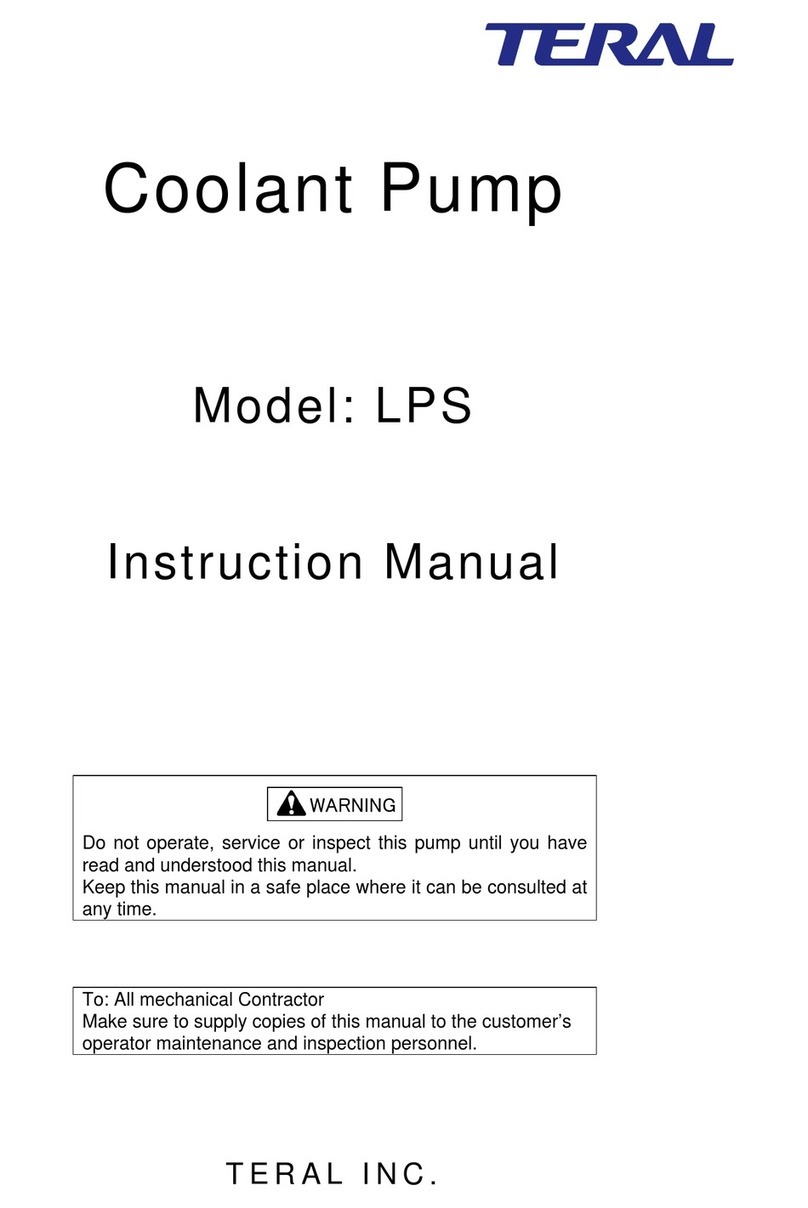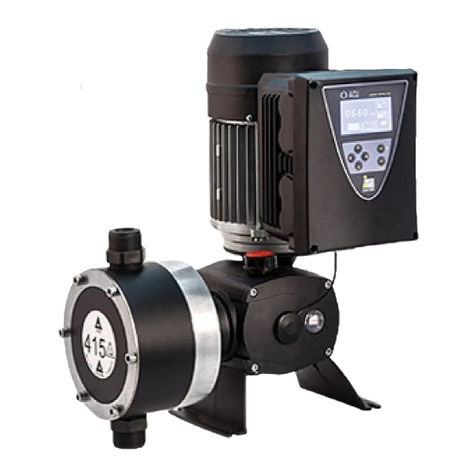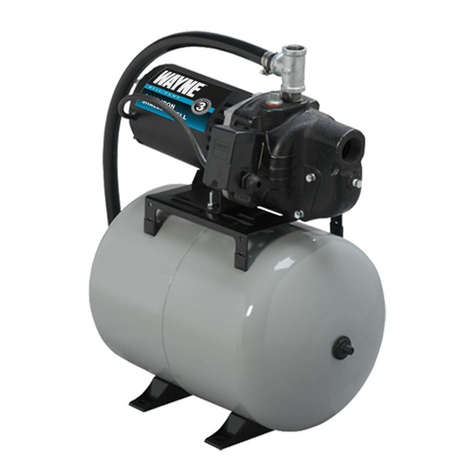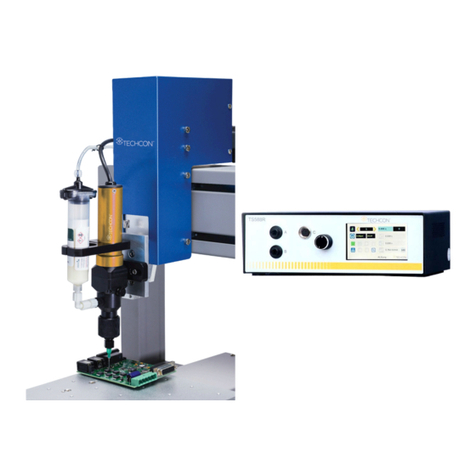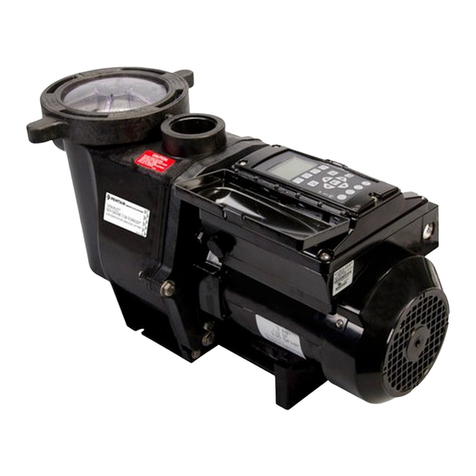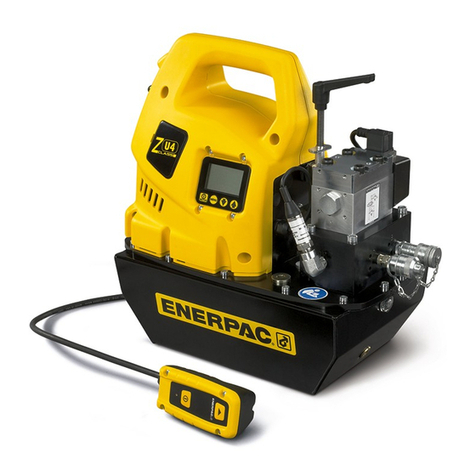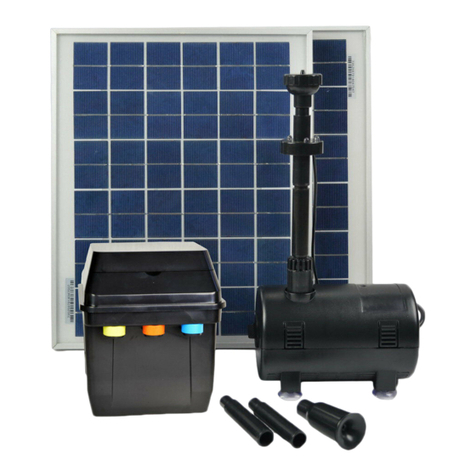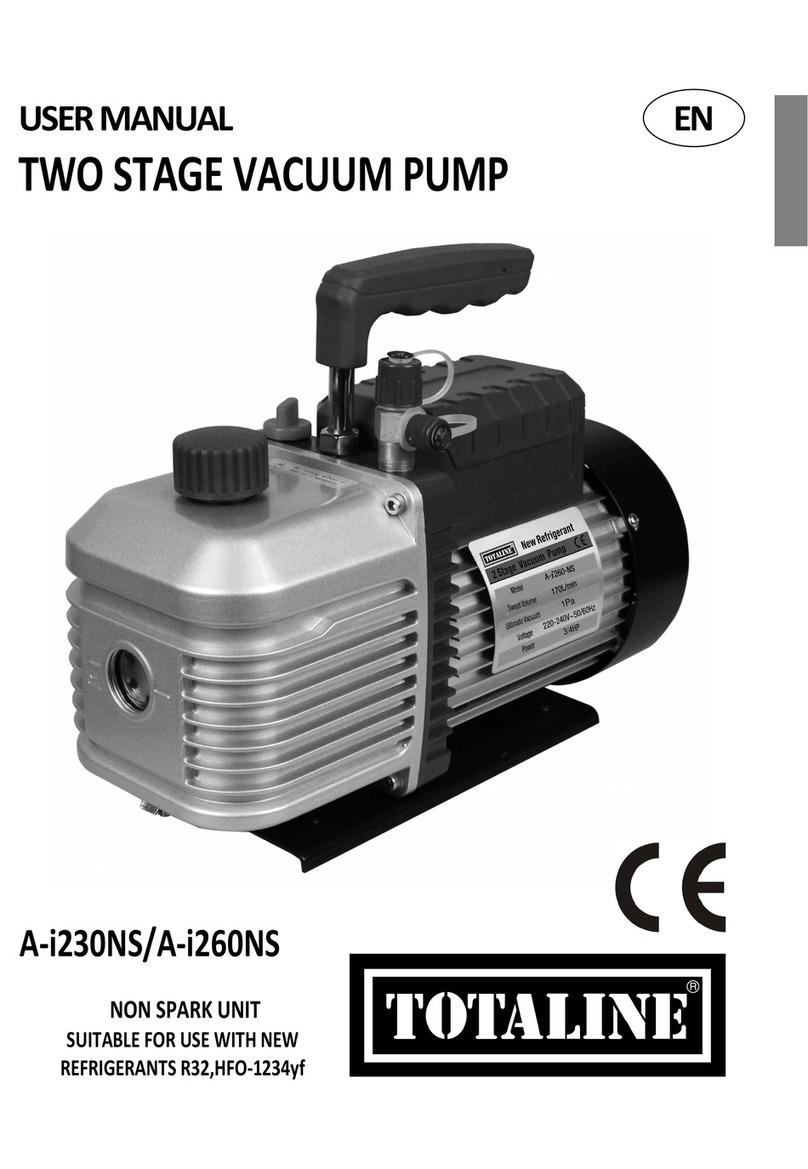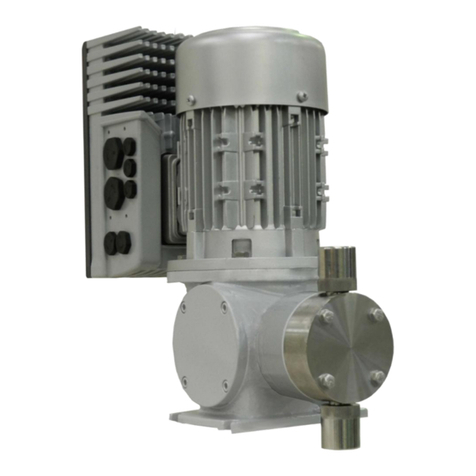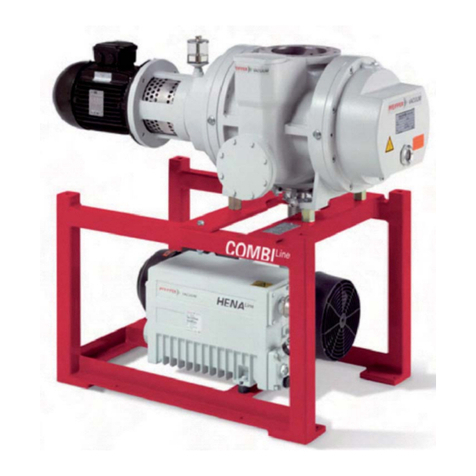Teral Patron SP-20 User manual

SP-20 / SP-25
Submersible Dewatering Pump
Operation Manual
Teral Inc.

OPERATION MANUAL
SUBMERSIBLE DEWATERING PUMP
Thank you for selecting SP-20/25 Submersible Pump for your pumping requirement.
Please take a moment to review this manual before, installing, operating or servicing these
pumps.
The pump should not be used other than the applications listed in this manual. Failure to
do so may lead to a malfunction or an accident to which the manufacturer will not assume
any liability.
After reading this Operation Manual, keep it in a location where it can be referred to during
the operational life of the pump.
In the event the product is damaged, please contact your authorized local dealer or sales
representative.
SAFETY FIRST
DANGER
CAUTION
NOTICE
I.
II.
III.
IV.
V.
VI.
VII.
VIII.
IX.
X.
2
2
3
4
5
6
7
8
9
9
Safety Instructions.........................
Before you Start.............................
Pump Identification........................
Installation....................................
Pump Operation.............................
Maintenance..................................
Repair Parts...................................
Preventative Maintenance...............
Trouble Shooting............................
Product Disposal............................
WARNING
Indicates a hazardous situation which, if not avoided WILL result in DEATH, SERIOUS INJURY,
PROPERTY DAMAGE.
Indicates a hazardous situation which, if not avoided MAY result in DEATH, SERIOUS INJURY,
PROPERTY DAMAGE.
Indicates a hazardous situation which, if not avoided MAY result in MINOR or MODERATE INJURY,
PROPERTY DAMAGE.
Indicates special instructions which are very important and must be followed.
Content

OPERATION MANUAL
SUBMERSIBLE DEWATERING PUMP
Thank you for selecting SP-20/25 Submersible Pump for your pumping requirement.
Please take a moment to review this manual before, installing, operating or servicing these
pumps.
The pump should not be used other than the applications listed in this manual. Failure to
do so may lead to a malfunction or an accident to which the manufacturer will not assume
any liability.
After reading this Operation Manual, keep it in a location where it can be referred to during
the operational life of the pump.
In the event the product is damaged, please contact your authorized local dealer or sales
representative.
SAFETY FIRST
DANGER
CAUTION
NOTICE
I.
II.
III.
IV.
V.
VI.
VII.
VIII.
IX.
X.
2
2
3
4
5
6
7
8
9
9
Safety Instructions.........................
Before you Start.............................
Pump Identification........................
Installation....................................
Pump Operation.............................
Maintenance..................................
Repair Parts...................................
Preventative Maintenance...............
Trouble Shooting............................
Product Disposal............................
WARNING
Indicates a hazardous situation which, if not avoided WILL result in DEATH, SERIOUS INJURY,
PROPERTY DAMAGE.
Indicates a hazardous situation which, if not avoided MAY result in DEATH, SERIOUS INJURY,
PROPERTY DAMAGE.
Indicates a hazardous situation which, if not avoided MAY result in MINOR or MODERATE INJURY,
PROPERTY DAMAGE.
Indicates special instructions which are very important and must be followed.
Content

SAFETY INSTRUCTION
BEFORE YOU START
PUMP IDENTIFICATION
All electrical work must be performed by an authorized electrician, in compliance with
local electrical codes. NEVER, allow an unauthorized person to perform electrical work
as it could lead to electrical shock, fire, or damaging the pump.
Risk of Electrical Shock. The pump comes supplied with a grounding conductor and a
grounding type attachment plug. NEVER, operate a pump with a plug in type power
cord without a ground fault circuit interrupter. Keep power end connection dry.
Upon receiving the pump, inspect for damages or shortages.
NEVER, use the power cord to lift or lower the pump. ALWAYS, tie a chain or rope to
the handle of the pump to lift and lower the pump.
NEVER, splice or use damaged or worn cables and cords.
ALWAYS, disconnect the electrical power before servicing the pump.
DO NOT, pump liquids which are flammable.
DO NOT, operate pump in a hazardous environment.
Risk of Electric Shock, this pump has not been investigated for use in a swimming pool
application.
When installing the pump, be mindful of the pump's center of gravity and weight.
Failure to do so, may result in the pump to fall and break which may lead to injury.
This pump is NOT designed for applications involving Acid, or Alkaline.
NEVER, operate the pump dry. Doing do so will damage the seals and overheat the
motor.
Periodically, check the oil level and water in the seal chamber. Check the seal condition
quarterly for heavy duty applications or annually otherwise.
This manual does not fully cover all safety issues. For this reason, the person using or
maintaining the pump must pay special attention to their own safety as well as those
around.
NEVER, pump water with a temperature greater than 30°C.
Check the name plate of the pump to ensure product is of the correct specification you
ordered. Ensure that the voltage and frequency are correct.
Please check the nameplate on the received pump against your ordered pump.
Paying special attention to the Model, Output(Hp), Voltage and Frequency.

SAFETY INSTRUCTION
BEFORE YOU START
PUMP IDENTIFICATION
All electrical work must be performed by an authorized electrician, in compliance with
local electrical codes. NEVER, allow an unauthorized person to perform electrical work
as it could lead to electrical shock, fire, or damaging the pump.
Risk of Electrical Shock. The pump comes supplied with a grounding conductor and a
grounding type attachment plug. NEVER, operate a pump with a plug in type power
cord without a ground fault circuit interrupter. Keep power end connection dry.
Upon receiving the pump, inspect for damages or shortages.
NEVER, use the power cord to lift or lower the pump. ALWAYS, tie a chain or rope to
the handle of the pump to lift and lower the pump.
NEVER, splice or use damaged or worn cables and cords.
ALWAYS, disconnect the electrical power before servicing the pump.
DO NOT, pump liquids which are flammable.
DO NOT, operate pump in a hazardous environment.
Risk of Electric Shock, this pump has not been investigated for use in a swimming pool
application.
When installing the pump, be mindful of the pump's center of gravity and weight.
Failure to do so, may result in the pump to fall and break which may lead to injury.
This pump is NOT designed for applications involving Acid, or Alkaline.
NEVER, operate the pump dry. Doing do so will damage the seals and overheat the
motor.
Periodically, check the oil level and water in the seal chamber. Check the seal condition
quarterly for heavy duty applications or annually otherwise.
This manual does not fully cover all safety issues. For this reason, the person using or
maintaining the pump must pay special attention to their own safety as well as those
around.
NEVER, pump water with a temperature greater than 30°C.
Check the name plate of the pump to ensure product is of the correct specification you
ordered. Ensure that the voltage and frequency are correct.
Please check the nameplate on the received pump against your ordered pump.
Paying special attention to the Model, Output(Hp), Voltage and Frequency.

Electrical
The electrical voltage required to operate this pump can burn, shock, or even cause
death. Before, installing, operating or servicing this pump, please thoroughly read
this manual.
DO NOT operate this pump anywhere near explosive or flammable material.
Serious personal injury, death, or major property damage will result.
Accidental starting of the pump can cause severe injury or death.
DO NOT, splice the power cord.
It is absolutely essential that the rotation of the pump be checked. All the pumps
covered in this manual turn clockwise as viewed from the motor end.
If the motor protector trips frequently, check for the cause. It could be due to impeller
blockage, wrong/low voltage, etc…
For Automatic operation, the pump must stop before the water level reaches Pump
Minimum Water Level.(W.M.L.)
This pump comes with a built in motor protector. In the event of a current overload
or overheating, the pump will stop automatically to protect the motor. After the motor
cools down, the motor protector will automatically reset and the pump can be used
again.
DO NOT, handle or service the pump while it is connected to the power supply.
ALWAYS, ensure that the voltage and frequency supplied to the pump are correct.
Refer to the nameplate to determine the correct voltage and frequency.
ALWAYS, make sure the pump is grounded properly in accordance to local law.
DO NOT, connect the ground wire to gas pipe, water pipe, etc… as improper
grounding will result in electrical shock.
PUMP OPERATION
DANGER
INSTALLATION
ALWAYS, place the pump in an upright position. Ensure, that the pump will not burrow
itself on the soft sand or mud.
All piping must be independently supported, properly aligned and capable of handling
semi-solids.
DO NOT, restrict the discharge flow of the pump as it will cause the pump to overheat.
Be mindful of the discharge hose whipping under pressure.
To avoid backflow or outflow of the pump. Backflow, discharge hose is above the water
surface. Outflow, the discharge hose is above the source water surface.
NEVER, allow the pump to freeze in the liquid it is pumping.
Pump Mount
Piping
NOTICE
NOTICE

Electrical
The electrical voltage required to operate this pump can burn, shock, or even cause
death. Before, installing, operating or servicing this pump, please thoroughly read
this manual.
DO NOT operate this pump anywhere near explosive or flammable material.
Serious personal injury, death, or major property damage will result.
Accidental starting of the pump can cause severe injury or death.
DO NOT, splice the power cord.
It is absolutely essential that the rotation of the pump be checked. All the pumps
covered in this manual turn clockwise as viewed from the motor end.
If the motor protector trips frequently, check for the cause. It could be due to impeller
blockage, wrong/low voltage, etc…
For Automatic operation, the pump must stop before the water level reaches Pump
Minimum Water Level.(W.M.L.)
This pump comes with a built in motor protector. In the event of a current overload
or overheating, the pump will stop automatically to protect the motor. After the motor
cools down, the motor protector will automatically reset and the pump can be used
again.
DO NOT, handle or service the pump while it is connected to the power supply.
ALWAYS, ensure that the voltage and frequency supplied to the pump are correct.
Refer to the nameplate to determine the correct voltage and frequency.
ALWAYS, make sure the pump is grounded properly in accordance to local law.
DO NOT, connect the ground wire to gas pipe, water pipe, etc… as improper
grounding will result in electrical shock.
PUMP OPERATION
DANGER
INSTALLATION
ALWAYS, place the pump in an upright position. Ensure, that the pump will not burrow
itself on the soft sand or mud.
All piping must be independently supported, properly aligned and capable of handling
semi-solids.
DO NOT, restrict the discharge flow of the pump as it will cause the pump to overheat.
Be mindful of the discharge hose whipping under pressure.
To avoid backflow or outflow of the pump. Backflow, discharge hose is above the water
surface. Outflow, the discharge hose is above the source water surface.
NEVER, allow the pump to freeze in the liquid it is pumping.
Pump Mount
Piping
NOTICE
NOTICE

STORAGE:
Disassembling the pump or modifying the pump will void manufacturer warranty.
ALWAYS, check that the voltage and amperage readings are in line with the nameplate
of the pump. Check if the water level is normal.
If the pump will not be used for a long period of time, wash the pump under tap water
removing any debris. Allow the pump to dry and then store indoors. Before, reinstalling
perform a test run to ensure it is operating correctly and within the parameters stated on
the nameplate
NOTICE
REPAIR PARTS
If the pump must be disassembled for repair, please contact an Authorized Dealer in
your area.
Accidental starting of the pump can cause severe injury or death. ALWAYS,
disconnect the electrical power before examining/working on the pump.
For heavy parts, use a hoist lift to avoid injury.
MAINTENANCE
CABLE OUTER COVER
BEARING
LUBRICANT
M. SEAL
OIL SEAL
IMPELLER
WEAR PLATE
STRAINER
CASING COVER
CAP NUT
OILPLUG GASKET
HANDLE
BEARING
BRACKET
SHAFT
CAPACITOR
UPPER COVER
1 8
9
10
11
12
13
14
15
16
17
18
2
3
4
5
6
7

STORAGE:
Disassembling the pump or modifying the pump will void manufacturer warranty.
ALWAYS, check that the voltage and amperage readings are in line with the nameplate
of the pump. Check if the water level is normal.
If the pump will not be used for a long period of time, wash the pump under tap water
removing any debris. Allow the pump to dry and then store indoors. Before, reinstalling
perform a test run to ensure it is operating correctly and within the parameters stated on
the nameplate
NOTICE
REPAIR PARTS
If the pump must be disassembled for repair, please contact an Authorized Dealer in
your area.
Accidental starting of the pump can cause severe injury or death. ALWAYS,
disconnect the electrical power before examining/working on the pump.
For heavy parts, use a hoist lift to avoid injury.
MAINTENANCE
CABLE OUTER COVER
BEARING
LUBRICANT
M. SEAL
OIL SEAL
IMPELLER
WEAR PLATE
STRAINER
CASING COVER
CAP NUT
OILPLUG GASKET
HANDLE
BEARING
BRACKET
SHAFT
CAPACITOR
UPPER COVER
1 8
9
10
11
12
13
14
15
16
17
18
2
3
4
5
6
7

PREVENTATIVE MAINTENANCE
Pump Fails
to Start
Incorrect Voltage/AmpsCheck power and correct connections.
Replace Power Cable
Replace with new protector.
Replace Motor
Replace Float Switch
Repair or Replace Control Panel
Remove foreign debris from impeller
or casing.
Check power to ensure it corresponds to
the nameplate
Change the power connection
Change the Impeller.
Remove debris
Remove obstruction
Replace with new cable
Reconnect after drying out.
Replace mechanical seal and oil seal
Replace with new motor.
Change the power connection
Decrease the viscosity of the liquid
Remove debris from the pump.
Check the power to make sure it
corresponds to the nameplate.
Check if pump is completely submerged.
Ensure the liquid temperature being
pumped is below 30°C.
Remove foreign debris from impeller
or casing.
Defective Cable
Clogged Impeller
Burned Out Motor
Defective Float Switch
Bad Control Panel
Jammed Impeller
Irregular Voltage
Tripped Motor Protector
Incorrect Rotation
Strainer is clogged
Damaged Power Cable
Wet Cable Terminals
Burned out Motor
Irregular Voltage
Incorrect Rotation
Highly Viscous Liquid
Debris inside the pump
Damaged Bearings
Worn out mechanical seal
causes water to enter.
Worn Out or Damaged
Impeller
Non Functioning Motor
Protector
SYMPTOM SOLUTION
Fails to
Deliver Full
Output
ELCB Trips
High
Amperage
Pump Starts
but
Immediately
Stops
PRODUCT DISPOSAL
Properly dispose the product in accordance with your local waste disposal program.
IX
X
89
1.Ensure the Voltage and Amperage conform to the nameplate.
Maintenance is recommended when the insulation reading is lower
than 10MReplace new motor immediately when insulation is
lower than 1M .
Inspecting of Lubricant:
For pumps1hp, the item should be checked every 3000 hours
or 12 months (whichever comes first).
For pumps2hp, the item should be checked every 6000 hours
or 12 months (whichever comes first).
PS:Loosen the oil plug screw and check the color of the lubricant. If
the lubricant is non-translucent, please change the mechanical seal
and the lubricant immediately. Apply adhesive before resecuring
the oil plug screw to strengthen the screw against leakage.
1Replacing Lubricant:
For pumps1hp, the item should be replaced every 4500 hours
or 24 months (whichever comes first).
For pumps2hp, the item should be replaced every 9000 hours
or 24 months (whichever comes first).
2change mechanicalsealInspectingand replacingthe mechanical
sealOnlyqualifiedmechanicswith propertoolsandknowledge
should be attempting to servicethis pumporcontactourauthorized
local
1.During the typical operating cycle, it is recommended to have the
pump overhauled and inspected periodically. This preventative
maintenance activity can extend the pump operating life cycle.
2.Please contact your authorized local dealers.
Please record the following information for future reference:
Model Number:
Serial Number:
Purchase Date:
Biennial
PROBABLE CAUSE
Obstruction in Valves and
Pipes.
Replace with new Bearings.
dealer in your area.

PREVENTATIVE MAINTENANCE
Pump Fails
to Start
Incorrect Voltage/AmpsCheck power and correct connections.
Replace Power Cable
Replace with new protector.
Replace Motor
Replace Float Switch
Repair or Replace Control Panel
Remove foreign debris from impeller
or casing.
Check power to ensure it corresponds to
the nameplate
Change the power connection
Change the Impeller.
Remove debris
Remove obstruction
Replace with new cable
Reconnect after drying out.
Replace mechanical seal and oil seal
Replace with new motor.
Change the power connection
Decrease the viscosity of the liquid
Remove debris from the pump.
Check the power to make sure it
corresponds to the nameplate.
Check if pump is completely submerged.
Ensure the liquid temperature being
pumped is below 30°C.
Remove foreign debris from impeller
or casing.
Defective Cable
Clogged Impeller
Burned Out Motor
Defective Float Switch
Bad Control Panel
Jammed Impeller
Irregular Voltage
Tripped Motor Protector
Incorrect Rotation
Strainer is clogged
Damaged Power Cable
Wet Cable Terminals
Burned out Motor
Irregular Voltage
Incorrect Rotation
Highly Viscous Liquid
Debris inside the pump
Damaged Bearings
Worn out mechanical seal
causes water to enter.
Worn Out or Damaged
Impeller
Non Functioning Motor
Protector
SYMPTOM SOLUTION
Fails to
Deliver Full
Output
ELCB Trips
High
Amperage
Pump Starts
but
Immediately
Stops
PRODUCT DISPOSAL
Properly dispose the product in accordance with your local waste disposal program.
IX
X
89
1.Ensure the Voltage and Amperage conform to the nameplate.
Maintenance is recommended when the insulation reading is lower
than 10MReplace new motor immediately when insulation is
lower than 1M .
Inspecting of Lubricant:
For pumps1hp, the item should be checked every 3000 hours
or 12 months (whichever comes first).
For pumps2hp, the item should be checked every 6000 hours
or 12 months (whichever comes first).
PS:Loosen the oil plug screw and check the color of the lubricant. If
the lubricant is non-translucent, please change the mechanical seal
and the lubricant immediately. Apply adhesive before resecuring
the oil plug screw to strengthen the screw against leakage.
1Replacing Lubricant:
For pumps1hp, the item should be replaced every 4500 hours
or 24 months (whichever comes first).
For pumps2hp, the item should be replaced every 9000 hours
or 24 months (whichever comes first).
2change mechanicalsealInspectingand replacingthe mechanical
sealOnlyqualifiedmechanicswith propertoolsandknowledge
should be attempting to servicethis pumporcontactourauthorized
local
1.During the typical operating cycle, it is recommended to have the
pump overhauled and inspected periodically. This preventative
maintenance activity can extend the pump operating life cycle.
2.Please contact your authorized local dealers.
Please record the following information for future reference:
Model Number:
Serial Number:
Purchase Date:
Biennial
PROBABLE CAUSE
Obstruction in Valves and
Pipes.
Replace with new Bearings.
dealer in your area.

SP-20 / SP-25
Submersible Dewatering Pump
Operation Manual
Teral Inc.
This manual suits for next models
1
Table of contents
Other Teral Water Pump manuals
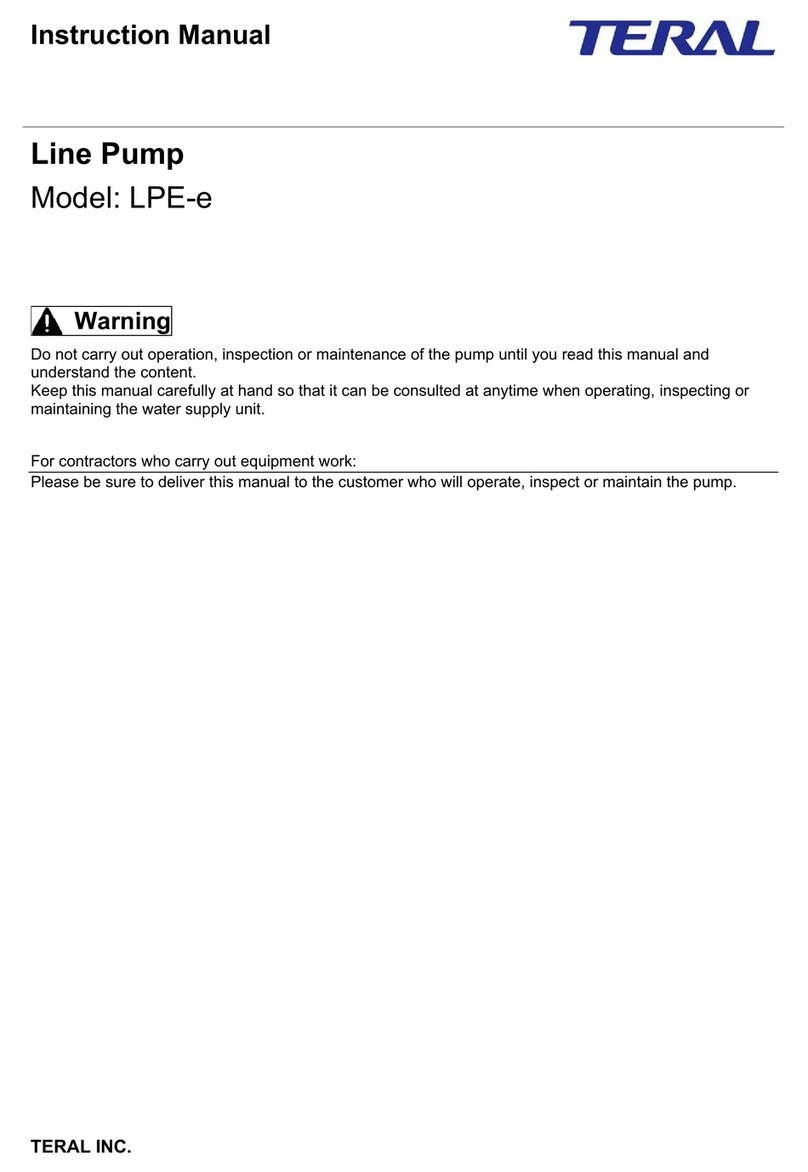
Teral
Teral LPE-e User manual
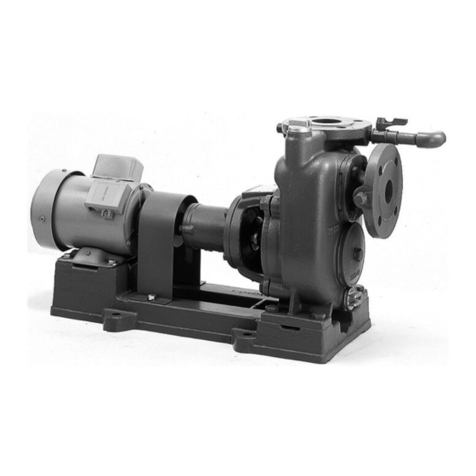
Teral
Teral SP3-e User manual
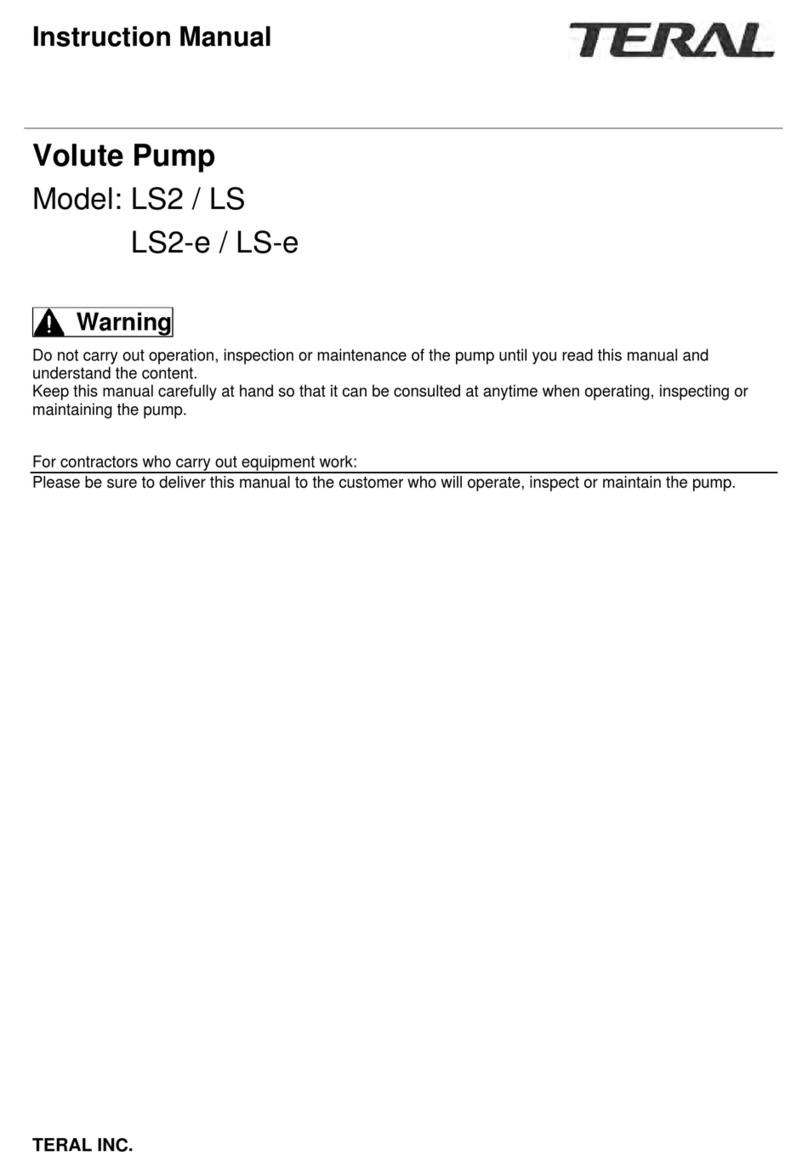
Teral
Teral LS2 User manual

Teral
Teral Patron SP-10 User manual
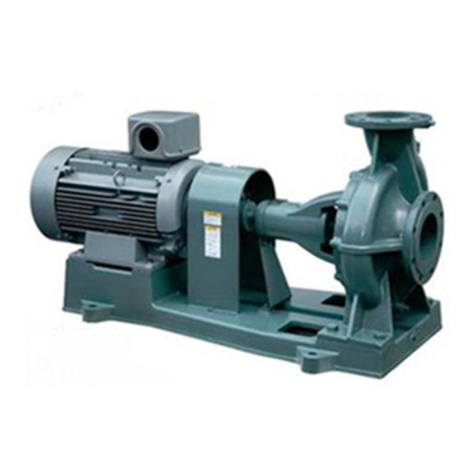
Teral
Teral S User manual

Teral
Teral LPWE-GS User manual
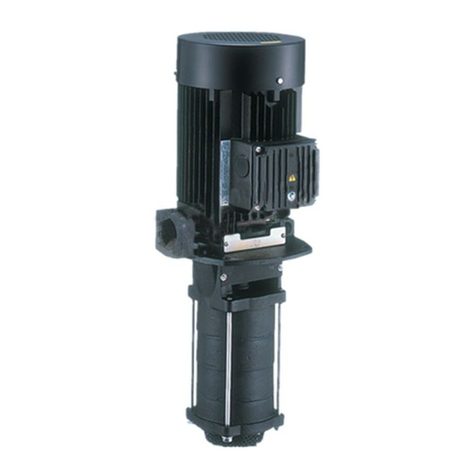
Teral
Teral VKD-e Series User manual
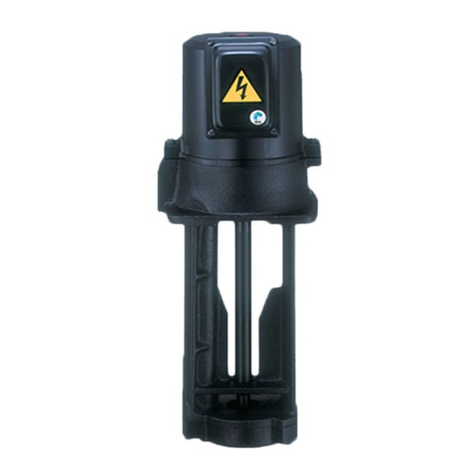
Teral
Teral VKN-e Series User manual

Teral
Teral VFZ Series User manual

Teral
Teral LHW-e User manual

